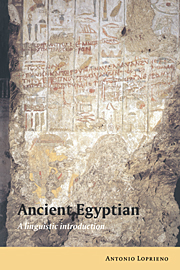Book contents
- Frontmatter
- Contents
- Preface
- Major Chronological Divisions of Egyptian History
- 1 The language of Ancient Egypt
- 2 Egyptian graphemics
- 3 Egyptian phonology
- 4 Elements of historical morphology
- 5 Nominal syntax
- 6 Adverbial and pseudoverbal syntax
- 7 Verbal syntax
- Epilogue
- Notes
- References
- Index of passages
- Index of morphemes
- Index of lexemes
- Index of topics
2 - Egyptian graphemics
Published online by Cambridge University Press: 08 December 2009
- Frontmatter
- Contents
- Preface
- Major Chronological Divisions of Egyptian History
- 1 The language of Ancient Egypt
- 2 Egyptian graphemics
- 3 Egyptian phonology
- 4 Elements of historical morphology
- 5 Nominal syntax
- 6 Adverbial and pseudoverbal syntax
- 7 Verbal syntax
- Epilogue
- Notes
- References
- Index of passages
- Index of morphemes
- Index of lexemes
- Index of topics
Summary
Introduction
The basic graphic system of the Egyptian language for three fourths of its life as a productive language, i.e. from about 3000 BCE to the first centuries of our era, is known as “hieroglyphic writing.” This term has been used since the Ptolemaic period (323–30 BCE) as the Greek counterpart (ἱερογλυφικὰ γὰρμματα “sacred incised letters”) to the Egyptian expression mdw.w-ntr “god's words.” Throughout Egyptian history, hieroglyphs were used primarily for monumental purposes, their main material support being stone or, less frequently, papyrus. For cursive uses the hieroglyphic system developed two handwriting varieties, called “Hieratic” (ἱερατιοκὰ γράμματα “priestly writing”), documented from the Old Kingdom through the third century CE, and “Demotic” (δημοτικὰ γράμματα “popular writing”), from the seventh century BCE to the fifth century CE. In a process beginning in Hellenistic times and concluded with the complete Christianization of the country in the fourth century CE, hieroglyphs and their manual varieties were gradually superseded by alphabetic transcriptions of words, and then of whole texts, inspired by the Greek alphabet with the addition of Demotic signs to render Egyptian phonemes unknown to Greek. The final result of this process is the emergence of “Coptic,” the name given to the Egyptian language and its alphabet in its most recent form, which remained in productive use from the fourth century to the end of the first millennium CE, when it was superseded by Arabic as the common language of the country.
Unlike other writing systems of the Ancient Near East, for example Mesopotamian cuneiform, hieroglyphs were never used to write down any language other than Egyptian, except for their later adoption in Meroitic.
- Type
- Chapter
- Information
- Ancient EgyptianA Linguistic Introduction, pp. 11 - 27Publisher: Cambridge University PressPrint publication year: 1995



